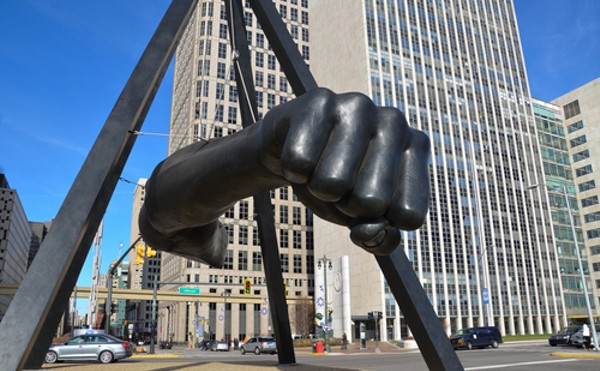The Detroit Beautification Project continues in Hamtramck, with new murals seemingly going up every week. Last weekend, we were fortunate enough to meet artists Dabs and Myla, hard at work on the western wall of Composite Lodge on Caniff near Lumpkin, thanks to a heads-up from DBP co-organizer Matt Eaton. Their work was cartoonish and eye-catching, a big cartoon spray paint can holding a roller and wearing royal robes. They said nobody seemed to disapprove, though one motorist rode by advising, "No caskets!"
The remark about the casket is doubtless a reference to a high-profile piece by Sever, which we interpreted as a commentary on the nature of the art project, with a high-profile sponsorship and city approval. Other residents interpreted it as Hamtramck's councilmembers carrying Hamtramck to the grave. (How they could do that when it's clearly labeled "street art" is beyond our ken.)
Again, this was city-approved work done by high-profile, internationally recognized street artists. How do you know it's street art? Street art is legal. The work of street artists is signed. Throughout Hamtramck, street artists received permission to do the work from the property owners. And their work is professional and visually stimulating. See, graffiti is used by gang members and "taggers" use to mark their territory, sort of like some animals urinate on a wall to mark their territory, to show, "I'm here," or "This place is mine." And graffiti is ugly and drives down property values. Very different from street art -- although, as our coverage last week showed, some local philistines seem unable to make the distinction.
And so, we are grateful to some local who gave us an excellent example of the difference between street art and graffiti.
According to local sources, the building at Goodson Street and Joseph Campau was defaced at night after the bars closed sometime this weekend. The message, "This is my city," though perhaps intended to be a reply to Sever's work, is a classic example of graffiti.
How do we know this is graffiti and not street art? First of all, this is illegal. It is unsigned. The person who tagged this wall did it under cover of night, unlike the street artists who work cheerfully by day; you can bet your boots the tagger didn't receive permission to do this. It's ugly. It will certainly affect the property values of the building. And, finally, unlike the imaginative street art we've seen, this graffiti is obviously used by a local to mark territory.
We don't approve of illegal graffiti, but we couldn't help but take this opportunity to show the differences between the two, which are especially conspicuous when you see them side-by-side. We can only hope that the vandal is caught and forced to pay for sandblasting off this tag.
POSTSCRIPT: It has come to our attention that the original graffiti on the wall on Goodson Street read a bit differently. It read, "This is not my city." We presume that somebody selectively sandblasted the word "not" from it. We gotta say, it's a clever retort that simultaneously removes blight. Kudos to whoever scrubbed off at least a little graffiti.





